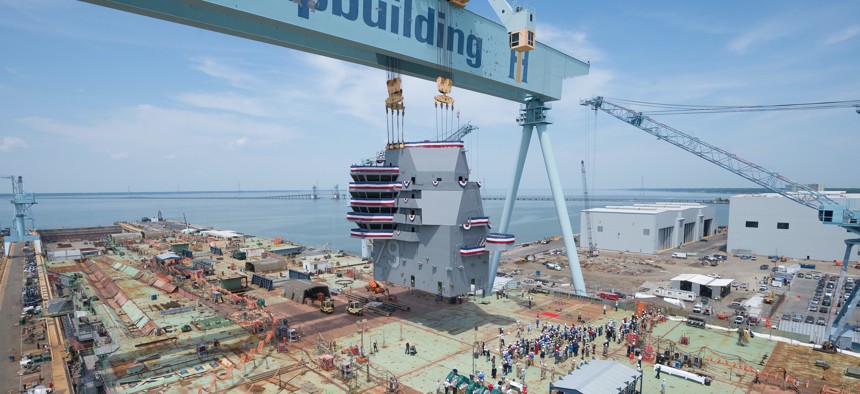
The island of the aircraft carrier USS John F. Kennedy (CVN 79) is landed onto the flight deck during a mast-stepping ceremony at Huntington Ingalls Industries Newport News Shipbuilding in Newport News, Va., May 29, 2019. U.S. Navy / Matt Hildreth
The $76 Billion Cost of a Yearlong Continuing Resolution
Inflation is making 2022 a terrible year to lack a budget. Congress must act.
Unless Congress acts soon, the Defense Department will operate for the rest of the year under a “continuing resolution,” which handcuffs this year’s funding to last year’s priorities. This would be deeply misguided at a moment when the world is as dangerous as it’s been in decades.
Congress will have to face a choice come Feb. 18: fully fund the federal government, or continue playing Russian roulette with our national security.
The National Defense Authorization Act, which Congress passed on a wide bipartisan basis and which President Biden already signed into law, sets the defense topline at $790 billion. This includes funding for the DOD ($740 billion), the Energy Department’s national security activities, and most of the nation’s intelligence agencies. The 2022 authorization act contains $38 billion more than the enacted 2021 budget. As long as the Department is forced to operate under a continuing resolution, DOD will not be able to use the increased funding.
Under a CR, individual program accounts are stuck at the previous year’s levels, resulting in billions of severely misaligned dollars. We’re locked into spending money based on the last decade’s priorities, not the next decade’s needs.
For example, the 2021 budget included $3 billion for the war in Afghanistan—a conflict the U.S. has since withdrawn from. Without additional reprogramming authorities passed by Congress, these funds cannot be used until the full appropriations act is passed. It is the height of absurdity to force DOD to operate under this unnecessary budget misalignment.
Moreover, CRs halt new programs and forbid certain changes to current programs. This impedes the Department’s ability to improve readiness and reach modernization goals necessary to address the threats of the world today.
Key programs would be severely affected, including those related to hypersonic weapons, shipbuilding, space, AI, quantum, and cyber, as well as increased funding to the European Deterrence Initiative and the Pacific Deterrence Initiative to combat the threats we face from Russia and China. These programs and capabilities are paramount for the U.S.’s ability to deter, compete, and overcome our adversaries.
A CR is bad enough any year, but 2022’s record inflation means the Pentagon is losing about $5 billion to $6 billion a month in purchasing power, further shrinking its ability to modernize and procure the technologies needed to confront threats.
To put the current situation in context: the effects of a yearlong CR would be more harmful than even the worst year of the Budget Control Act sequester of 2013. The sequester cut 10 percent ($70 billion) from overall defense spending. A yearlong CR would cut $76 billion from the purchasing power enacted in the 2022 authorization act.
Remember, the Budget Control Act was designed to be such bad policy that it would force legislators to reach a reasonable budget compromise. That failed, resulting in the disastrous sequester regime which wreaked havoc on the military’s readiness.
Why should we repeat the mistake?
In January, the House Appropriations Subcommittee on Defense heard testimony from the military service chiefs, who outlined how a yearlong CR would hurt their services—from hurting key programs, research and development, to recruiting and retaining our invaluable servicemembers.
Will Congress listen? Lawmakers must do their constitutional duty and pass the funding bills on time. The notion that yearlong CRs are not harmful is objectively incorrect. They are detrimental to our national security. We must heed the warnings from our nation’s top military leaders and ensure America’s national security capabilities are properly funded.
Mr. Punaro is a retired U.S. Marine major general and a former staff director of the Senate Armed Services Committee. He is the author of “The Ever-Shrinking Fighting Force.”





